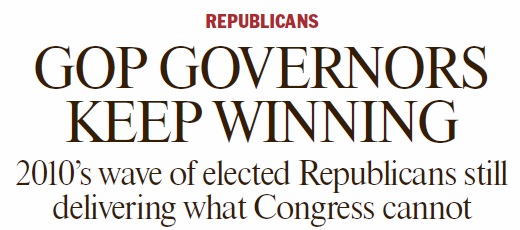
Across the country, Republican governors continue to deliver results for the people of their states. As the Washington Times reports in a new front page story today, states that elected Republican governors in 2010 have made inarguable progress by transforming their states for the better, driving economic growth, reinventing state government and expanding opportunity. As this story shows, Republican governors continue to be the best investment for advancing conservative policies in the states.
“Seventeen new Republican governors were elected in 2010 as part of the national GOP wave, and like their congressional counterparts, they promised to usher in a new era of booming economies, slimmer government and a bulwark against President Barack Obama.
Most have been successful in reviving their economies, and many made major strides in conservative policies such as limiting the power of public employee labor unions.
…
‘The class of 2010 did very well. They put in place some substantial tax cuts,’ said Chris Edwards, who studies state governors for the Cato Institute. But he added: ‘States get into fiscal trouble because of a lot of things outside of their control, like oil prices in a state that’s dependent on oil, like Oklahoma. Sometimes they have to do things that are unpopular to balance that.’
The wave of new GOP governors included a dozen who captured seats from Democrats or independents, including the big states of Florida, Ohio, Michigan and Pennsylvania. Five other GOP governors won seats that had been held by a Republican who was term-limited or lost in a primary.
…
In Wisconsin, Mr. Walker promised to bring the public sector labor unions to heel after a bitter battle that saw him have to win in the legislature, then in the courts, and then survive a recall election. Gov. John Kasich won a similar showdown in Ohio, though voters later overturned his new law.
In Iowa, Gov. Terry Branstad promised 200,000 new jobs by 2016. He and his critics debate whether he’s reached that goal, but as Mr. Branstad departs for a new job as the Trump administration’s ambassador to China, there’s little doubt the economy is humming: Unemployment in the state has shrunk from 5.6 percent to 3 percent.
Gov. Rick Scott also promised 700,000 jobs would be created in Florida, and he’s nearly doubled that, with 1.3 million private-sector jobs added between January 2011 and January 2017. Unemployment, which was a staggering 10.5 percent in January 2011, was just 5 percent at the beginning of this year.
In Michigan, Gov. Rick Snyder steered clear of hot-button issues, instead putting his effort into cleaning up the troubled city of Detroit. He put the city into managed bankruptcy in 2013, appointed an emergency manager to handle city assets and struck a deal with public-sector unions over benefits.
Within 16 months the city was out of bankruptcy, and Mr. Snyder gave talks around the country about how he achieved such a feat, even stirring up rumors of a presidential bid in 2016 that did not come to fruition.
…South Carolina Gov. Nikki R. Haley, also part of the class of 2010, was mentioned as a potential vice presidential pick. Instead, she has become President Trump’s ambassador to the U.N.
Of the 17 GOP governors newly elected in 2010, all but one won re-election in 2014. Mr. Thompson said that it was Republicans’ economic agenda that brought them political victory.
‘While Republican governors have been successful on multiple avenues of reform, a main focus was making their states strong engines of economic growth, and on that policy, they have exceeded expectations,’ he said.”
Read the full story here.





See the latest videos from RGA
Watch our videosThe numbers say it all. New Hampshire can’t afford to become @maura_healey's Massachusetts.
NEW: Eleven economic development projects in Ohio are expected to create 1,025 new jobs statewide.
Details: https://bit.ly/3J1ZYDO
Follow RGA on Twitter
Follow RGA on Facebook